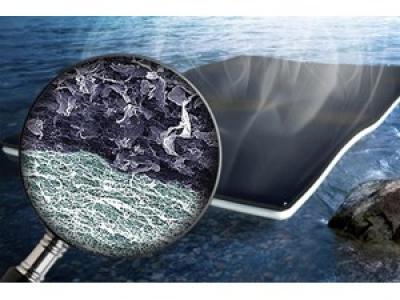A team of engineers at Washington University in St. Louis has found a way to use graphene oxide sheets to transform dirty water into drinking water, a discovery it says could be a global game-changer.
Srikanth Singamaneni, associate professor of mechanical engineering and materials science at the School of Engineering & Applied Science, said: “We hope that for countries where there is ample sunlight, such as India, you'll be able to take dirty water, evaporate it using our material, and collect fresh water.”
The new approach combines bacteria-produced cellulose and graphene oxide to form a bi-layered biofoam.
“The process is extremely simple,” Singamaneni said. “The nanoscale cellulose fibre network produced by bacteria has the ability to move the water from the bulk to the evaporative surface while minimising the heat coming down.
“The design of the material is novel here,” Singamaneni said. “You have a bi-layered structure with light-absorbing graphene oxide filled nanocellulose at the top and pristine nanocellulose at the bottom. When you suspend this entire thing on water, the water is actually able to reach the top surface where evaporation happens.
“Light radiates on top of it, and it converts into heat because of the graphene oxide - but the heat dissipation to the bulk water underneath is minimised by the pristine nanocellulose layer. You don't want to waste the heat; you want to confine the heat to the top layer where the evaporation is actually happening.”
The cellulose at the bottom of the bi-layered biofoam acts as a sponge, drawing water up to the graphene oxide where rapid evaporation occurs. The resulting fresh water can easily be collected from the top of the sheet.
In the same way an oyster makes a pearl, the bacteria forms layers of nanocellulose fibres in which the graphene oxide flakes get embedded.
“While we are culturing the bacteria for the cellulose, we added the graphene oxide flakes into the medium itself,” said Qisheng Jiang, graduate student in the Singamaneni lab. “The graphene oxide becomes embedded as the bacteria produces the cellulose. At a certain point along the process, we stop, remove the medium with the graphene oxide and reintroduce fresh medium. That produces the next layer of our foam.”
The new biofoam is said to be strong, light, mechanically robust and inexpensive to make, making it a viable tool for water purification and desalination.
“Cellulose can be produced on a massive scale,” Singamaneni said. “And graphene oxide is extremely cheap. Both materials going into this are highly scalable. So one can imagine making huge sheets of the biofoam.”
The team says it will be exploring other applications for these novel structures in future.
From Engineering Materials July 27, 2016

